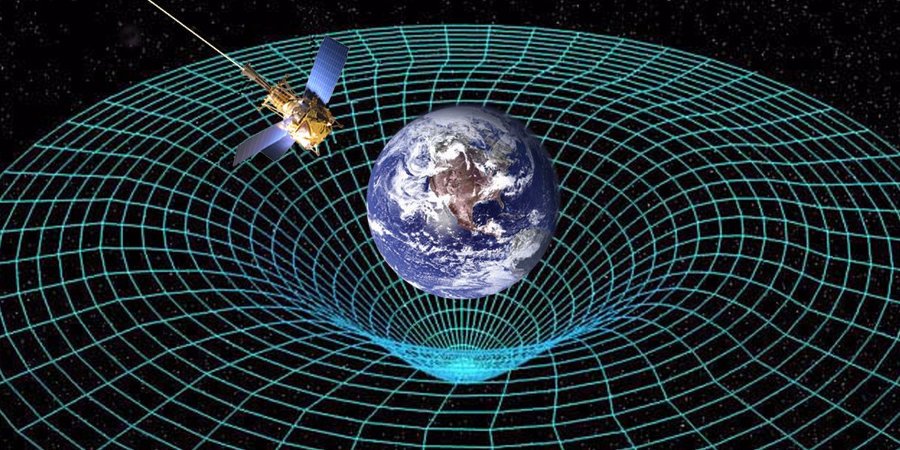It's so easy to say or write these words, "time", "space" and "common sense". We all know what they mean; it's currently 03:56 AM, September 1st 2018, and I'm sitting in my attic typing away in an effort to communicate something meaningful.

source: NASA Jet Propulsion Laboratory
I know where I am and I know when I am. These certainties, these truths, are so much part of my existence, so intertwined with my path through life, that they're just there, staring me in the face all the time while I'm conscious: in my dreams nothing is certain and half a lifetime can pass in a couple of minutes. Everything related to those daily truths about space and time have become common sense. Literally things that are common for our senses.
Common sense isn't always a good tool to discover truths about reality though, as Einstein proved; he would scuff at the title of this article and would laugh in the face of the author of such nonsense, as he has proven that time and space are in fact the same thing, not separate. His theory of special relativity, published in 1905 shows that there's only space-time and that within space-time space and time are not fixed, but are measured differently according to the relative speeds of observers or objects. There's only two constants in this theory. First constant is the laws of nature: they are the same for everyone everywhere all the time. Second constant is the speed of light: that's always the same, approximately 300,000 kilometers per second, independent of the observers location or speed.
This goes against common sense. When I observe When a train passes me at 100 km/h, I see it passing at 100 km/h. When a boy in that train throws a ball with a speed of 20 km/h in the direction of the movement of that train, I see the ball pass at a speed of 120 km/h: I must add the speeds. This does not work for light-speed, or ultra high speeds I should say. Because time and space are measured relative to speed in space-time, and the speed of light is absolute, this means that time just runs slower when you travel really fast.

Image by Free-Photos - source: Pixabay
If you could travel close to the peed of light and left the earth for a trip to a distant star, say 20 light-years away, and back, that trip would take a little more than 40 years: 20+ years to the star and 20+ years back to earth. But this would only be true for us on earth, waiting for you to come back; we would all have aged 40+ years. For you however, only a couple of years would have passed. Because from your viewpoint inside the spaceship, the distance wouldn't be 20 light-years anymore, but maybe just 3 light-years which would make a round-trip of a little over 6 years: from your perspective it would seem that you had traveled more than 30 years into the future!
Then in his theory of general relativity, published 10 years later in 1915, he showed us that gravity is nothing more than curvature of space-time by mass. Mass curves space-time; another highly counter-intuitive thing for us mere mortals to imagine. Einstein says that the earth orbits around the sun because the large mass of the sun bends space-time, and the earth's orbit simply follows the ridge of that circular curvature of space-time. But this is so difficult for us to imagine because we live in four-dimensional space-time; the best we can do is draw two-dimensional representations of what we mean by it, but we can never in our mind reproduce a visual of the reality of it.
Common sense fails when we try to describe extremes; Einstein showed that for the extremely large (space-time), the extremely heavy (planets, stars), and the extremely fast (light-speed), and a couple of years later quantum mechanics showed that even more counter-intuitive assumptions have to be made to describe the extremely small. Things that are not common to our senses. Still, Einsteins description of the universe and quantum mechanics are the best descriptions of reality we have. Don't get fooled by the word "theory" as it is the highest degree of certainty achievable in science.

curvature of space-time imagined in two dimensions - source: Ipressa
A theory is something that's proven so many times, that's made so many predictions that were shown to be true, that it's inconceivable that they'll ever be proven wrong. Newton's laws of gravity are not proven wrong by Einstein's general relativity, it only expands upon it and gives a better explanation of what gravity actually is. Newton's laws are good enough to calculate everything that's needed to launch a rocket into orbit. But it takes Einsteins general relativity to make our GPS work in our cars and on our mobile's. That's because time moves at a slightly different speed for the satellites orbiting the earth than here on the planet itself. It's a difference of only a few nanoseconds per day, but if we didn't incorporate that in the calculations, GPS wouldn't work and we'd all get lost. Because, who still knows how to read a map? ;-)
I'm writing this because reality is our common ground; reality is that which persists regardless of our perspective on that reality, independent of our opinion about it. It's what remains after we're all dead. As far as we know. Since science is the best way we know of to describe that reality, it's the best way for us to find that common ground. Even if it sometimes seems to contradict common sense.
Common sense now tells me I have to get some sleep... Thanks for visiting and I hope to see you back here tomorrow :-)

Recent articles you might be interested in:

Thanks for stopping by and reading. If you really liked this content, if you disagree (or if you do agree), please leave a comment. Of course, upvotes, follows, resteems are all greatly appreciated, but nothing brings me and you more growth than sharing our ideas. It's what Steemit is made for!


Just for Full Disclosure, I'm invested in these crypto-currencies:
Bitcoin | Litecoin | EOS | OmiseGo | FunFair | KIN | Pillar | DENT | Polymath | XDCE | 0x | Decred | Ethereum | Carmel | XYO
